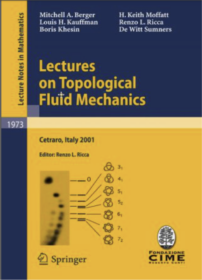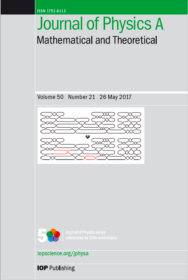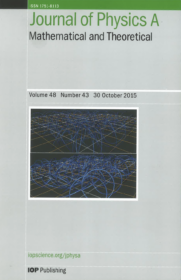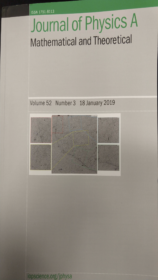2020
1. Moore A., and Vazquez, M. (2020) A note on band surgery and the signature of a knot. Bulletin of the London Mathematical Society 52 (6) 1191-1208.
2. Cruz B., Zhu Z., Calderer M-C., Arsuaga J. and Vazquez M. (2020) Quantitative study of the chiral organization of the phage genome induced by the packaging motor. Biophysical Journal 118 (9) 2013-2116.
3. Gonzalez G, Ushakova, A., Sazdanovic R. and Arsuaga J. (2020) Prediction in cancer genomics using topological signatures and machine learning. Proceedings of the Abel Symposium. Topological Data Analysis 247-276. Springer, Cham 2020.
4. Hiltner L., Calderer C., Arsuaga J., Vazquez M. (2020) Chromonic liquid crystals and packing configurations of bacteriophage viruses.
5. Liu P, Polischuck R, Diao Y and Arsuaga J. (2020) Characterizing the topology of kinetoplast DNA using random knotting. AMS Book chapter: Topology and Geometry of Biopolymers, 746, 17. (Ed. E. Flapan and H. Wong)
6. Walker S., Arsuaga J., Calderer M-C., Hiltner L and and Vazquez M. (2020) Liquid crystal model of viral DNA encapsidation. Physical Review E 101, 022703.
2019
1. Lidman T., Moore A., Vazquez M., Distance one lens space fillings and band surgery on the trefoil knot. Algebraic & Geometric Topology 19 (5):2439-2484.
2. Pouokam M, Cruz B, Burgess S, Segal M, Vazquez M, Arsuaga J (2019) Quantification of entanglement complexity of the yeast genome reveals a bias towards topological simplicity. Scientific Reports, 9(6795).
2018
1. Ibrahim L., Liu P., Diao Y., Michele K and Arsuaga J. (2018) Estimating properties of kDNA by unlinking reactions. J. Phys. A : Math. Theor 52(3):034001.
2. Witte S., Flanner M., Vazquez M., (2018) A symmetry motivated link table. Symmetry 10 (11): 604
2017
1. Arsuaga J., Calderer M-C., Hiltner L., Vazquez M., (2017) A liquid crystal model of viral dna encapsidation.arXiv preprint arXiv:1712.00629.
2. Ishihara, K; Pouokam, M; Suzuki, A; Scharein, R; Vazquez, M; Arsuaga, J; Shimokawa,
K (2017) Bounds for minimum step number of knots confined to tubes in the
simple cubic lattice J. of Phys. A : Math. Theor. 50 (21).
3. Stolz R., Yoshida M., Brasher R., Flanner M., Ishihara K., Sherratt D., Shimokawa K., Vazquez M., (2017) Pathways of DNA unlinking: A story of stepwise simplification. Scientific Reports 7 (1):1-11.
2016
1. Ardanza-Trevijano S., Gonzalez G., Borrman T. Garcia J.L. Arsuaga J. (2016) Toplogical Analysis of Amplicon Structure in Comparative Genomic Hybridization (CGH) Data: An Application to ERBB2/HER2/NEU Amplified Tumors. Lecture Notes in Computer Science. 9667, Springer 2016, ISBN 978-3-319-39440-4 (Peer Reviewed Book Chapter)
2015
1. Arsuaga J., Borrman T., Cavalcante R., Gonzalez G. and Park C (2015) Identification of Copy Number Aberrations in Breast Cancer Subtypes using Persistence Topology. Microarrays 4 (3):339-369
2. Arsuaga J., Heskia I., Hosten S., and Maskalevich T. (2015) Uncovering Proximity of Chromosome Territories using Classical Algebraic Statistics. Journal of Algebraic Statistics. 6 (2):133-149.
3. Arsuaga J., Jayasinghe R., Scharein R, Segal M and Vazquez M. (2015) Current analytical methods are insufficient to determine the topological complexity of the human genome. Frontiers in Molecular Biosciences, section Mathematics of Biomolecules 2(48).
4. Diao Y., Rodriguez V., Klingbeil M and Arsuaga J. Orientation of DNA minicircles balances density and topological complexity in kinetoplast DNA. Plos One 10(6): e0130998.
5. Hom J., Lidman T., Vafaee F., (2015) Berge–Gabai knots and L–space satellite operations. Algebraic & Geometric Topology 14 (6):3745-3763
2014
1. Arsuaga J., Diao Y, Klingbeil M. and Rodriguez V. (2014) Properties of Topological Networks of Flexible Polygonal Chains. Mol. Based. Math. Bio. 2: 98-106.
2. Ishihara K., Shimokawa K., Vazquez M., (2014) Site-specific recombination modeled as a band surgery: applications to Xer recombination. Discrete and topological models in molecular biology:387-401.
3. . Segal M, Xiong H, Capurso D, Vazquez M and Arsuaga J (2014) Reproducibility of three-dimensional chromatin configuration reconstructions. Biostatistics 15(3): 442-56.
2013
1. 4. Brasher R., Scharein R., Vazquez M., (2013) New biologically motivated knot table. Biochemical Society Transactions 41 (2):606-611.
2. Darcy I., Vazquez M., (2013) Determining the topology of stable protein–DNA complexes. Biochemical Society Transactions 41 (2):601-605.
2. Rodriguez V, Diao Y. and Arsuaga J. (2013) Percolation phenomena in randomized topological networks. J. Phys.: Conf. Ser. 454 012070
3. Shimokawa, K., Ishihara, K., Grainge, I., Sherratt, D., and Vazquez, M. (2013) FtsK-dependent
XerCD-dif recombination unlinks replication catenanes in
a stepwise manner Proceedings of the National Academy of Sciences 110 (52), 20906-20911
4. Vazquez M., (2013) DNA unlinking by Xer recombination. Publisher:Banff International Research Station for Mathematical Innovation and Discovery.
2012
1. Arsuaga J , Baas N, DeWoskin D, Mizuno H, and Pankov A, Park C (2012) A topological signature derived from expression profiles for the identification of breast cancer subtypes. Applicable Algebra in Engineering, Communication and Computing 23 (1) 3-15.
2. Arsuaga J, Diao Y and Hinson K (2012) The effect of angle restriction on the topological characteristics of minicircle networks. J. Stat. Phys. 146: 434-445.
3. Arsuaga J, Diao Y and Hinson K, (2012) The growth of minicircle networks on regular lattices, J. of Phys. A: Math. Theor. 45 035004
4. Diao Y, Hinson K, Kaplan R, Vazquez M, and Arsuaga J (2012) The effects of minicircle density on the topological structure of the mitochondrial DNA from trypanosomes. Journal of Mathematical Biology 64(6) 1087-1108
5. Ishihara K, Scharein R, Diao Y, Arsuaga J, Vazquez M, Shimokawa K (2012) Bounds for minimum step number of knots confined to slabs in the simple cubic lattice. J. of Phys. A : Math. Theor. 45 065003
2011
1. Blackstone, T, Scharein, R., Varela, R., Diao, Y., and Arsuaga J. (2011) Modeling Chromosome Intermingling Using Overlapping Uniform Random Polygons. Journal of Mathematical Biology 62(3): 371-89.
2. Portillo J, Diao Y,Scharein R, Arsuaga J and Vazquez M (2011) On the mean and the variance of the writhe. J. Phys A: Math Theor. 44 275004.
2010
1. Arsuaga J., Roca J. and Sumners D. W. Topology of viral DNA. (Book chapter) in “Emerging Topics in Physical Virology” Imperial College Press. (2010) Ed. P. G. Stockley and R. Twarock.
2. DeWoskin, D., Climent, J., Cruz-White, I., Vazquez, M., Park, C. and Arsuaga, J. (2010) Applications of Computational Homology to Prediction of Treatment Response in Breast Cancer Patients. Topology and Its Applications. 157 (1) 157-164
2009
1. Arsuaga J, Borgo B, Diao Y and Scharein R (2009) The Average Crossing Number of Equilateral Random Polygons in Confined Volumes. J. Phys. A: Math. Theor. 42 465202.
2. Arsuaga J, Diao Y and Vazquez M Mathematical methods in DNA topology: Applications to chromosome organization and site-specific recombination. IMA volumes in Mathematics and Its Applications. Volume 150: Mathematics of DNA Structure, Function, and Interactions (2009) Edited by Craig John Benham, Stephen Harvey, Wilma K. Olson, De Witt L. Sumners, and David Swigon. Springer Science + Business Media, LLC, New York. (Book chapter)
3. Scharein R, Ishihara K, Arsuaga J, Shimokawa K, Vazquez M (2009) Bounds for minimal step number of knots in the simple cubic lattice. J. Phys A: Math. and Theor 42 475006-457030
4. Varela R, Hinson K, Arsuaga J, Diao Y (2009) A fast ergodic algorithm for generating ensembles of polygons. J. Phys A: Math Theor. 42 095204 .
2008
1. Arsuaga J, and Diao Y (2008) DNA knotting in Spooling like conformations in Bacteriophages. Journal Computational and Mathematical Methods in Medicine 9 (3-4) 303-316.
2007
1. Ardanza-Trevijano S. Arsuaga J, Crespo JA, Extremiana J I, Hernandez LJ, Rivas MT, Roca J, Vazquez M (2007) La topologia como herramienta en otros campos. La Gaceta de la Real Sociedad Matematica Espanola 10 (3); 911-932. (Review)
2. Arsuaga, J., Blackstone, T., Diao,Y., Karadayi, E. , Saito, Y. (2007) Linking of Uniform Random Polygons in Confined Spaces. J. Phys. A: Math. Gen. 40: 1925-1936
3. Arsuaga J, Blackstone T, Diao Y, Karadayi E, Saito Y (2007) Knotting of Uniform Random Polygons in Confined Spaces. J. Phys. A: Math Gen. 40: 11697-11711
4. Blackstone T, McGuirk P, Laing C, Vazquez M, Roca J, and Arsuaga J. (2007) The role of writhing in DNA condensation. Proceedings of International Workshop on Knot Theory for Scientific Objects. OCAMI Studies Volume 1 (2) Osaka Municipal. Universities Press; 239-250 Osaka, Japan
5. Climent, J., Mao, J., Garcia, J. L., Arsuaga, J., Perez-Losada, J. (2007) Characterization of Breast Cancer by Array CGH. Biochemistry and Cell Biology 85(4); 497-508 (Review)
6. Hua X, Nguyen D, Raghavan B, Arsuaga J, Vazquez M. (2007) Random state transitions of knots: a first step towards modeling unknotting by type II topoisomerases. Topology and its Applications.154(7):1381-97.
2005
1. Arsuaga, J., Vazquez, M., McGuirk, P., Sumners D.W. and Roca J. (2005) DNA knots reveal a chiral organization of DNA in phage capsids. Proceedings of the National Academy of Sciences USA. 102(26):9165-9
2. Vives, S., Bradford, L., Vazquez, M., Brenner, D., Sachs, R. K., Hlatky, L., Cornforth, M. and Arsuaga, J. (2005) SCHIP: Statistics of Chromosome Interphase Positioning based on interchange data. Bioinformatics 21(14):3181-2.
2004
1. Arsuaga, J., Greulich-Bode, K., Vazquez, M., Brukner, M.,Hahnfeldt,P., Brenner, D.J., Sachs, R. and Hlatky, L. (2004) Chromosome positioning through radiogenic aberrations. International Journal of Radiation Biology 80 (7), 507-516.
2. Levy, D., Vazquez, M., Loucas, B. D., Cornforth, M. N., Sachs, R. K., Arsuaga, J. (2004) Comparing DNA damage-processing pathways by computer analysis of chromosome painting data. Journal of Computational Biology 11(4): 626-641.
3. Peter, B., Arsuaga, J., Breier, A., Khodursky, A., Brown, P., and Cozzarelli N. R. (2004) Genomic analysis of supercoiling sensitive genes in Escherichia coli: responses to topoisomerase inhibition. Genome Biology 5 (11) R-87.
4. Postow, L., Hardy, C., Arsuaga, J. and Cozzarelli, N. R. (2004) Topological domain structure of the Escherichia coli chromosome. Genes and Development. 18(14):1766-79.
2002
1. Arsuaga, J., Tan, R., Vazquez, M., Sumners, D. W., and Harvey, S. C. (2002) Investigation of Viral DNA Packaging Using Molecular Mechanics Models. Biophysical Chemistry, 101-102(1): 475-484.
2. Arsuaga J, Vazquez, M., Trigueros, S., Sumners, D. W., and Roca, J. (2002) Knotting probability of DNA molecules confined in restricted volumes: DNA knotting in phage capsids. Proceedings of the National Academy of Sciences USA 2002, 99(8):5373-5377
3. Cornforth, M. N., Greulich-Bode, K. M., Loucas, B. D., Arsuaga, J., Vazquez, M., Daye,J., Sachs, R. K.,Bruckner, M., Molls, M., Hahnfeldt, P., Hlatky, L., Brenner, D. J. (2002) Chromosomes are predominantly located randomly with respect to each other in interphase human cells. The Journal of Cell Biology 159 (2), 237-244.
4. Sachs, R. K., Arsuaga, J., Vazquez, M., Hahnfeldt, P., and Hlatky, L. (2002) Using graph theory to analyze chromosome aberrations. Radiation Research 158 (5): 556-567.
5. Vazquez, M., Greulich-Bode, K. M., Arsuaga, J., Cornforth, M. N., Bruckner, M., Sachs,R. K., Hahnfeldt, P., Molls, M., Hlatky, L. (2002) Computer analysis of mFISH chromosome aberration data uncovers an excess of very complex metaphases. International Journal of Radiation Biology 2002, 78(12): 1103-1115.
2001
1. Trigueros, S., Arsuaga, J., Vazquez, M., Sumners, D.W., Roca, J. (2001) Novel display of knotted DNA molecules by two dimensional gel electrophoresis. Nucleic Acids Research, 29 (13): e67.



